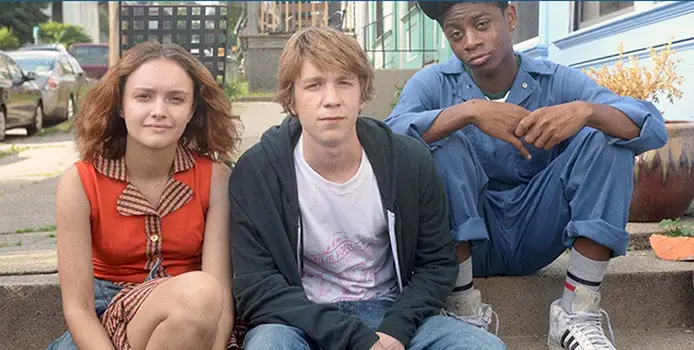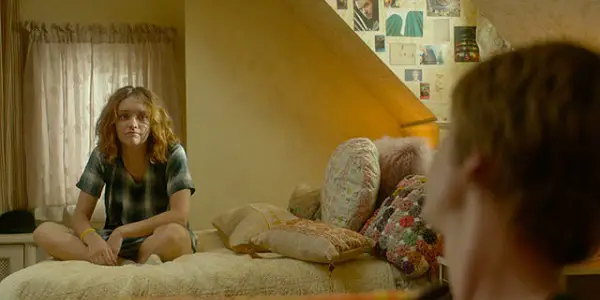ME AND EARL AND THE DYING GIRL: Narcissistic and Utterly Loathsome From Start to Finish

Alistair is a 25 year old writer based in Cambridge.…
Although not without empathy, it is hard to argue against the statement that teenagers are some of the most self-centred people alive. I know this from being a particularly self-centred teenager, who at thirteen regularly made statements of self-loathing in order to gouge sympathy and attention from my peers. It was an attention seeking phase that I mercifully grew out of very quickly, but I can at least be forgiven for it for being young and stupid. Greg Gaines, the main character in the inexplicably overrated Me and Earl and The Dying Girl, shares many of the same character traits that I did when I was thirteen – a desire to be ubiquitous among his peers, yet simultaneously invisible and mysterious.
These aren’t characters – these are stereotypes
Like me, these traits are from a similarly self-centred place; in narrating the film telling us about how unpopular he is, he marginalises every other character (including both Earl and the dying girl) until they are nothing more than character archetypes, whilst exhibiting constant self-effacement disguised as self-loathing in order for the audience and the characters onscreen to sympathise with him. These traits would be forgiven if the character was thirteen and foolish. Instead, the character is 18 years old and heading off for college. Throughout the course of the film, his narcissistic character traits are never questioned and the entire film feels like a hagiography to him and his elitist worldview. Even without the most detestable central character in recent years, Me and Earl is one of the most problematic films I have seen recently – how it could be so universally adored is beyond my understanding.

The film announces how annoying it is going to be from its opening seconds, as Greg (Thomas Mann) gives a voice-over narration peppered with obvious literary references, as well as other references to pop-culture cynically included in order for the movie to be deemed “cool” by the hipster audiences it shamelessly panders to. One day, Greg is forced by his parents (Nick Offerman and Connie Britton) to go and hang out with schoolmate Rachel (Olivia Cooke), who has just been diagnosed with leukemia. Being entirely without empathy, he only visits due to being forced to. Reluctantly, the two strike up a friendship and Rachel eventually grows to love the low-budget parodies of arthouse movies him and “co-worker” Earl (Ronald Cyler II) make regularly, that Greg naturally hates. A plan is devised by one of Rachel’s friends for Greg and Earl to make a cinematic tribute to Rachel, an act of empathy that somewhat inexplicably causes Greg’s narcissism to skyrocket to untold heights.
As I have stated, the main problem is that Greg’s narcissistic tendencies are never challenged; he doesn’t grow as a person throughout his character arc, despite the best efforts of the rest of the characters. Of course, this egotism is right there in the film’s title. There is a reason he has placed his name before his best friend, whilst reducing Rachel to be a simple “dying girl”. Their narratives in the film only exist in proximity to him, and we never see their life if it isn’t relevant to Greg’s story. In a surprising element of restraint, Earl has been given his name in the film’s title, in the place of “stereotypical token black friend”, the reductive stereotype that summarises what use he has to the narrative.

We are shown Earl’s house in a rough neighbourhood; this, included with the fact that his sole character trait is to talk repeatedly about “titties”- it’s a distillation of two central elements of hip-hop culture utilised as character background because the screenwriter (Jesse Andrews, adapting his novel) couldn’t be bothered to think of anything original that would challenge stereotypes. We are frequently shown Earl enjoying arthouse cinema and fine cuisine, yet this is only in scenes with Greg. Without him in the picture, he is reduced to a borderline offensive character archetype. The brief glimpses we get at other cliques in the school, most notably the goth guy, seem so unbelievable you are left begging for John Hughes to make a posthumous apology for inventing the idea of cliques in the first place.
Even worse is the characterisation of Rachel, the most offensive rendering of the “manic pixie dream girl” archetype I have ever seen. A term introduced by the critic Nathan Rabin, a manic pixie dream girl is a quirky, free-spirited female character who exists solely to help male characters find happiness in their lives, with no other function to the plot. In a film where the manic pixie dream girl in question is dying of a serious illness, for her to have no other function than to help the central character achieve happiness when conventional logic suggests that the reverse should be happening, left me feeling somewhat puzzled. She is dying of a serious disease yet is focusing all her time and effort at writing to colleges telling them they should accept Greg, whilst telling him point-blank that he should learn to embrace life. I’m not going to spoil the end of the film, but all I’m going to say is, the things I cannot mention about Rachel’s arc in relation to Greg’s are even more cynical and offensive.
A Cynical Love of Cinema
The reason the film has been embraced at film festivals is unquestionably because of the film remakes Greg and Earl make, which are parodies of cultishlly adored films based around awful puns, including “A Sockwork Orange” and “Brew Velvet”. Although the initial montage sequence of these remakes is funny, it eventually proves to be cynical, included solely to attract the attention from cinephile audiences, who will forgive it for all its flaws because of its elitist arthouse film references. You are left wondering where Greg and Earl found the time to make over forty full-length parody films, channelling everybody from Ingmar Bergman to Federico Fellini. You soon realise that there is no way they ever could, as these are just there to show how much director Alfonso Gomez-Rejon loves arthouse cinema and how much he wants to convey it to an audience to prove that he is a serious filmmaker underneath all the comedy.
This film demands respect in a way as narcissistic as its main character, thinking that making jokes about Werner Herzog is enough to buy itself critical admiration; watched at a preview screening outside of a film festival, the jokes proved to fall flat on mainstream audiences. It is including these arthouse film references for the sake of doing so, hoping that conveying a knowledge of cinema is enough to ensure good reviews from cultured critics, who will overlook the shocking offensiveness of everything underneath just because it has a strong understanding of film history.

There are positives in this cinematic catastrophe. Firstly, with the exception of the twee stop-motion sequences littered intermittently, the film is visually interesting throughout, with conventional dialogue scenes being shot from unusual angles in order to give it a sense of distinction. The problem is that, as good as it is to look at, the distinctive visuals are distinctive of two more renowned directors entirely: Wes Anderson and Edgar Wright. It recalls Wright in how characters visually exit the frame; a scene where Greg leaves the school dinner table in a state of embarrassment echoes how Scott Pilgrim ran away from awkward situations in Scott Pilgrim Vs. The World.
The Wes Anderson influence runs far deeper. As well as using lots of his visual trademarks, the narrative (a social outsider with a narcissistic streak who desires to be ubiquitous amongst his peers) is very close to that of Rushmore. Whereas that film dismantled the idea of a Manic Pixie Dream girl trope before there was even a name for it and allowed for its character to have growth, Me and Earl stubbornly refuses to change throughout, as if to assume we are so in love with this character that we would feel heartbroken for him to exhibit any personal growth. Overall, it has the directorial flourishes of a “calling card” movie; a visually slick breakthrough that remains indistinctive enough to ensure Gomez-Rejon’s next film is likely going to be a $200 million budgeted franchise movie.
Conclusion
As well as being one of the most sickeningly overrated films of the year, Me and Earl and the Dying Girl is one of the worst. The central character’s rampaging ego would love for you to go and watch this hagiography dedicated to him. But I want this film and the annoyingly self-centred emotions within to die a death as slow and painful as that of the sidelined dying girl of the title.
Me and Earl has proved to be divisive – what did you think of it? Which critically adored film do you think has been overrated this year?
Me and Earl and the Dying Girl is out now in the US and is released on September 4 in the UK. All international release dates can be found here.
(top image source: Fox Searchlight Pictures)
Does content like this matter to you?
Become a Member and support film journalism. Unlock access to all of Film Inquiry`s great articles. Join a community of like-minded readers who are passionate about cinema - get access to our private members Network, give back to independent filmmakers, and more.
Alistair is a 25 year old writer based in Cambridge. He has been writing about film since the start of 2014, and in addition to Film Inquiry, regularly contributes to Gay Essential and The Digital Fix, with additional bylines in Film Stories, the BFI and Vague Visages. Because of his work for Film Inquiry, he is a recognised member of GALECA, the Gay & Lesbian Entertainment Critics' Association.












